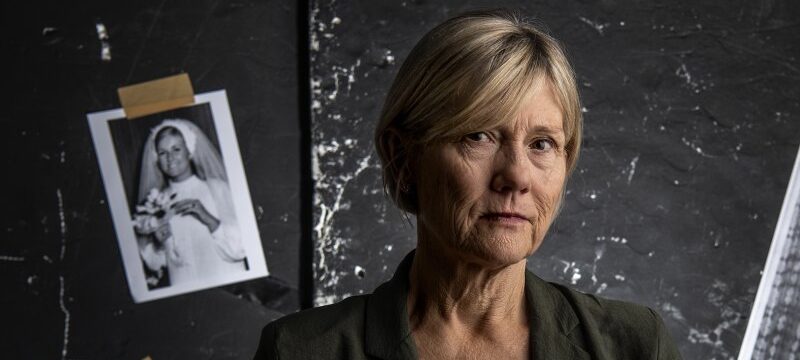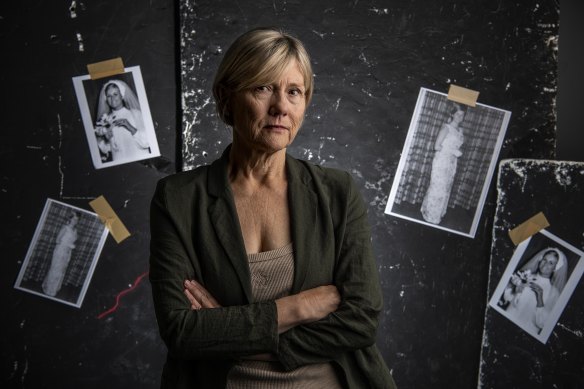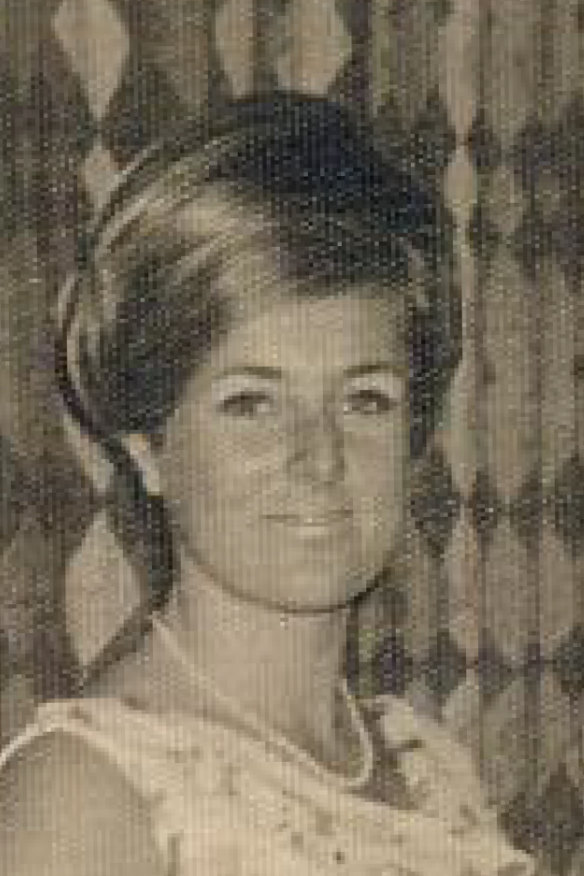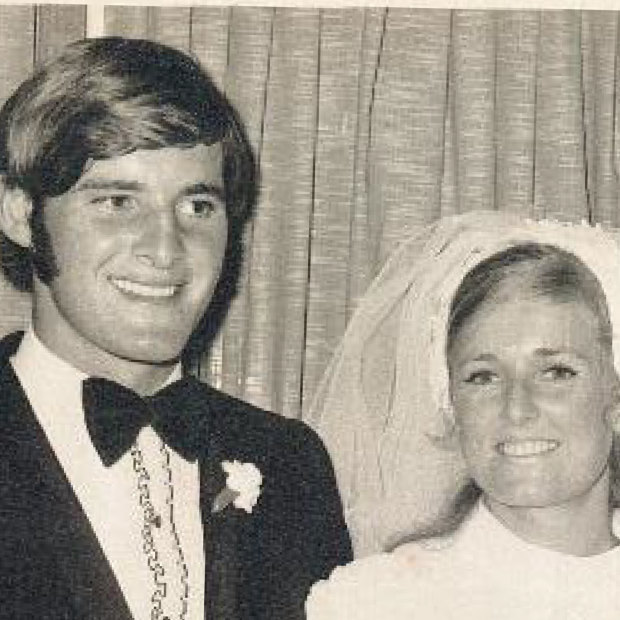By Helen Pitt
Save articles for later
Add articles to your saved list and come back to them any time.
Rebecca Hazel was chatting with a colleague over coffee in 2007 when she first heard the disturbing story of Lynette Dawson, the 33-year-old mother who disappeared from her Bayview home in 1982.
“I married a man whose first wife had gone missing,” the woman told her. “I moved into the house not long after. We got married a few years later. She’s never been heard from since … The police think that he killed her”.
Rebecca Hazel, author of The Schoolgirl, Her Teacher and His Wife.Credit: Steven Siewert
Hazel and the woman were co-workers at a women’s refuge on the northern beaches.
If Hazel, a lawyer, hadn’t heard those words, it is unlikely former teacher and rugby league star Chris Dawson would be in jail serving a 24-year sentence for the murder of his wife Lynette, and a further three years for grooming and sexually abusing a teen in the 1980s.
Hazel had been intrigued by the story since that 2007 conversation, long before she appeared on The Teacher’s Pet true-crime podcast in 2018. The women’s shelter was in an ordinary suburban street, and the two workmates often ate their lunch together in the refuge. They were only a year apart in age, and a friendship quickly formed.
“She was smart and had a quick, dark sense of humour,” Hazel said of the refuge worker who had a psychology degree and was a single mother.
When Hazel learnt the man’s name was Chris Dawson, she Googled him and so many articles came up she couldn’t understand how she’d not heard the story before. She realised her friend was the “16-year-old schoolgirl” who had been groomed and abused by Dawson, and then moved into his house, days after Lynette’s disappearance.
The more she delved, the more obsessed Hazel became with the sad story of both women.
“It stayed with me,” Hazel said.
Lynette Dawson.
In 2012, with a husband away a lot for work and three young children, she started doing the legwork to write a book, with her friend’s blessing.
“I’ve always thought this story should be told,” the friend told her.
Hazel has spent over a decade working to give a voice to the female victims at the heart of this story, and finally, after three attempts at publication that were aborted due to legal issues, her book The Schoolgirl, Her Teacher and His Wife is out on October 3.
In 2018, the book was days from printing when Dawson was charged with the murder of his wife, 35 years earlier.
It is the only first-hand account of the story, through the eyes of the schoolgirl Dawson pursued. Dawson was last week found guilty of entering into an unlawful sexual relationship with her and jailed for a further three years.
Her frank revelations to Hazel and the police, in part led to the opening of the homicide investigation decades after Lynette’s disappearance, had been filed away as an unsolved missing persons case.
Hazel felt great empathy for her colleague and could also relate to the story of Lynette, the 33-year-old middle-class mother of two small girls who vanished without a trace.
“We were both middle-class suburban women living on the northern beaches – I really related to Lynette too.”
Over the years, Hazel has gathered evidence, trawled through coroners’ reports from 2001 and 2003 and police files, met and interviewed detectives, and family members, to paint a portrait of these two women. At first, she couldn’t understand how the police had so botched an investigation, but reminds us these were the days before “coercive control”, “narcissists” and “domestic violence” had become part of our vocabulary.
While the grisly details of the case have been played out in both the courts and in the podcast by journalist Hedley Thomas, Hazel’s book aims to tell us more about the lives of both women.
Before she married and moved to Bayview, Lynette Simms spent her childhood in Clovelly, the book says.
The second youngest in a family of four, she was a keen swimmer. She swam in summer in the Coogee Aquarium (now the Coogee Pavilion) and in winter at Wylie’s Baths at the south end of the beach.
Chris and Lynette Dawson on their wedding day in 1970.Credit: NSW Supreme Court
While a student at Sydney Girls High, she started dating Dawson, from Sydney Boys’ when they were both 15. Chris and his twin brother Paul, were the youngest of five from Maroubra; both handsome and athletic. The twins went to university together, both studied physical education, played rugby for Easts Rugby Union then rugby league for Newtown Jets. In 1970, when Chris and Lynette were both 21, they married.
Lynette, who couldn’t drive, moved far away from her beloved parents, to Bayview, making a home in the bushy suburb with their two young daughters while working in a childcare centre. But she became increasingly isolated. And confused when her husband moved one of his students into their marital home.
As in the court cases, the schoolgirl cannot be identified, so throughout the book she is known as JC. She grew up in a dysfunctional home. At the age of 13, she came home to find her mother having sex with her godfather. She felt unwanted and unsafe.
Her father left the marriage in 1977, leaving JC and her sisters alone in the care of their alcoholic mother.
Soon after, the godfather of one of JC’s sister’s moved into the flat she shared with her mother and two sisters. They were married in 1980, but it was an abusive relationship.
That was the same year she was at Cromer High, and the new PE teacher, Chris Dawson, started paying her a lot of attention. By the end of the following year, she would be living with him.
During the course of understanding her story, Hazel went with JC back to the open day at Cromer High School.
“I find it hard to believe Cromer High was the only school where such things happened, but it sounded like a free-for-all for teachers back then. JC used to tell me one of her friends was seeing a teacher,” Hazel said.
The book details how JC moved into the Dawson home to find herself caring for two young girls aged two and four, when she didn’t even know how to cook and was just getting her HSC results.
She later married and moved to Queensland with Dawson. But it was giving birth to her own daughter in 1985, that changed JC’s perspective, said Hazel.
“When she became a mother she knew that Lynette could never leave her daughters – it was then that it really crystallised what had happened,” Hazel said.
JC left Dawson, taking their daughter when she was five, leaving Queensland, landing back in Sydney.
In 1990 she went to the police, to report her suspicions of what had happened to Lynette, and it was only after that Dawson was questioned for the first time by police in relation to his wife’s disappearance. Until then, she had been classed as a missing person.
A homicide investigation followed but got nowhere until 1998, when Detective Sergeant Damian Loone was handed Lynette’s file. For nearly two decades he made it his business to honour Lynette and to find out what had happened to her. His work led to two coronial investigations, but no charges.
Hazel’s book outlines how this case remained completely unresolved for decades – despite suspicions from family and friends that Lynette had been murdered. She captures some of their frustrations and frank revelations. JC recalled Dawson telling her he’d tried to find a hitman to get rid of his wife, but did not pursue it. Lynette’s sister Pat even wrote to underworld figure Neddy Smith in Long Bay Jail, to ask if he had been involved in Lynette’s disappearance because her family knew of his connections to the Newtown Jets club, where Dawson was highly respected. Smith never received the letter, nor was he implicated in the disappearance.
It also details the murder trial, where Hazel was called as a witness, recalling “the red-faced hatred” Dawson had when she caught his stare in the courtroom.
“After all these years I’ve never met anyone associated with this case that thought he was innocent,” Hazel said.
But what of the fact no body has been found? She has many theories: Dawson, who had worked as a part-time garbage man, could have disposed of it in a tip, or somewhere off the Pacific Highway on his drive up the north coast to retrieve JC just days after his wife went missing. But they are sheer speculation.
The Simms family say Hazel’s work helped lead to a conviction in the case of their missing sister; what they call their “40-year battle for justice for Lyn”.
“Rebecca came to us in 2012, at a time when we had almost lost hope for anything progressing in Lyn’s case. She was offering us an opportunity to be able to give Lyn a voice in conjunction with JC’s story,” Lyn’s brother Greg Simms said.
Greg Simms (right) the brother of Lynette Dawson with his wife Merilyn Simms (left).Credit: Kate Geraghty
“Rebecca was very gentle and considerate and we felt we could trust her to write the story without embellishment, yet with accuracy and sensitivity. She has definitely achieved that.”
Greg’s wife, Merilyn said: “Rebecca needs to be acknowledged for the commitment and thoroughness of her research and for her part in bringing justice for Lyn through her generosity in sharing her research with [Teacher’s Pet podcast creator] Hedley Thomas.
“Our hope is, that in the future, Lyn’s case will be seen as a landmark, one of learning for the police, the media and the public. Lyn’s case is an example of how well this can work.”
The Schoolgirl, Her Teacher and His Wife is out October 3.
The Booklist is a weekly newsletter for book lovers from books editor Jason Steger. Get it delivered every Friday.
Most Viewed in Culture
Source: Read Full Article




